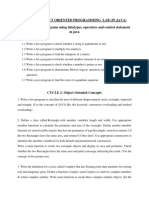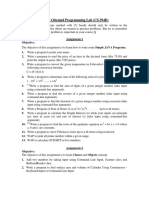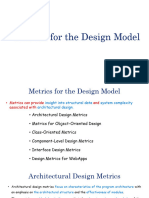0 ratings0% found this document useful (0 votes)
6 viewsWeek01-Lab-Classes and Objects
The document discusses implementing classes in Java to model space exploration missions. It describes creating Spacecraft, Astronaut and SpaceMission classes to represent key entities, their attributes and interactions. Methods are defined to add/remove astronauts from missions while ensuring valid capacities. The Main class demonstrates interactions between the classes.
Uploaded by
Varent LionelCopyright
© © All Rights Reserved
We take content rights seriously. If you suspect this is your content, claim it here.
Available Formats
Download as DOCX, PDF, TXT or read online on Scribd
0 ratings0% found this document useful (0 votes)
6 viewsWeek01-Lab-Classes and Objects
The document discusses implementing classes in Java to model space exploration missions. It describes creating Spacecraft, Astronaut and SpaceMission classes to represent key entities, their attributes and interactions. Methods are defined to add/remove astronauts from missions while ensuring valid capacities. The Main class demonstrates interactions between the classes.
Uploaded by
Varent LionelCopyright
© © All Rights Reserved
We take content rights seriously. If you suspect this is your content, claim it here.
Available Formats
Download as DOCX, PDF, TXT or read online on Scribd
You are on page 1/ 4
MODULE 1
CLASSES AND OBJECTS
NASA has task to create a Space Exploration Mission Planner represents a
fascinating and instructive challenge. This project aims to simulate the complex operations
involved in planning and executing space missions, albeit on a much-simplified scale. By
focusing on the core components of space exploration—spacecraft, astronauts, and the
missions themselves—this project provides a practical application of object-oriented
programming (OOP) principles in Java, one of the most versatile and widely used
programming languages in the world.
Java's OOP capabilities make it an ideal choice for modeling real-world entities and
their interactions. In this project, we will design and implement three primary classes:
Spacecraft, Astronaut, and SpaceMission. Each class will encapsulate specific attributes and
behaviors relevant to its real-world counterpart, such as the spacecraft's type and capacity, the
astronaut's rank and specialization, and the mission's duration and crew composition. By
adhering to Java's OOP principles, such as encapsulation, inheritance, and polymorphism, we
can create a modular and scalable system that could, in theory, be expanded into a more
complex simulation.
The Spacecraft class will model various types of spacecraft, focusing on attributes
like name, type (e.g., shuttle, satellite), speed, and capacity. The Astronaut class will
represent individuals with specific roles and skills, necessary for the success of space
missions. The SpaceMission class will tie these elements together, managing the logistics of
space missions, including the assignment of spacecraft and crew.
To demonstrate the interactions between these classes and the functionality of our
system, we will also create a Main class. This class will serve as the entry point for the
simulation, using arrays of objects to manage and manipulate multiple spacecraft, astronauts,
and missions simultaneously. Through this approach, we aim to illustrate not only the
technical aspects of Java programming but also the thought processes behind modeling
complex systems in a simplified manner.
Basic Questions
a. Implement the Spacecraft Class:
Create a Spacecraft class with attributes for name, type (e.g., shuttle, satellite, cargo,
crewed), speed, and capacity. Include a constructor to initialize these attributes and
methods to get and set their values. Create one method named "launch" to print the
spacecraft name.
b. Implement the Astronaut Class:
Design an Astronaut class with attributes for name, rank (e.g., commander, pilot),
and specialization (e.g., engineer, scientist). Provide a constructor for initializing
these attributes and appropriate getter and setter methods. Create one method named
"performEVA" to print the Astronaut's name.
c. Implement the SpaceMission Class:
Develop a SpaceMission class with attributes for mission name, duration (in days),
assigned spacecraft, and crew (an array of Astronauts). Include methods to add or
remove astronauts from the crew. Create one method to print the SpaceMission name
and print all the signed all astronaut name.
Intermediate Questions
a. Array Management in SpaceMission:
Write a method in the SpaceMission class to add an astronaut to the mission,
ensuring there's no duplication of astronauts. Implement another method to remove
an astronaut by name.
b. Spacecraft Assignment:
In the SpaceMission class, implement a method to assign a Spacecraft to the mission,
ensuring that the spacecraft's capacity is not exceeded by the astronaut crew size.
Example of the Main Class:
Expected Output:
You might also like
- Cover Page_20231221_071949_0000 (1).pdf (3) (1).pdf.pdfNo ratings yetCover Page_20231221_071949_0000 (1).pdf (3) (1).pdf.pdf30 pages
- Java Lab 2025_B.tech-4th Semester_Upto ArrayNo ratings yetJava Lab 2025_B.tech-4th Semester_Upto Array5 pages
- Cover Page_20231221_071949_0000 (1).pdf (3) (1).pdfNo ratings yetCover Page_20231221_071949_0000 (1).pdf (3) (1).pdf41 pages
- AllPossibleQuestionBank (Desc&Obj) ..R22 OOPSJAVA 2324SEM1..14112023No ratings yetAllPossibleQuestionBank (Desc&Obj) ..R22 OOPSJAVA 2324SEM1..1411202318 pages
- Tutorial 02 Type Hierarchy: 1 Chapter Exercises100% (1)Tutorial 02 Type Hierarchy: 1 Chapter Exercises6 pages
- WINSEM2024-25_BCSE103E_ELA_VL2024250505256_MODEL-QUESTION-PAPERNo ratings yetWINSEM2024-25_BCSE103E_ELA_VL2024250505256_MODEL-QUESTION-PAPER30 pages
- Solution Manual for Java Software Solutions 9th by Lewis instant download100% (5)Solution Manual for Java Software Solutions 9th by Lewis instant download46 pages
- 3 - Sem - Bcs306a - Oop With Java - Lab - Manual - 2023-24No ratings yet3 - Sem - Bcs306a - Oop With Java - Lab - Manual - 2023-2422 pages
- Jets Java Subset For IB Computer ScienceNo ratings yetJets Java Subset For IB Computer Science9 pages
- Solution Manual for Java Software Solutions 9th by Lewis - Quickly Download For The Best Reading Experience100% (6)Solution Manual for Java Software Solutions 9th by Lewis - Quickly Download For The Best Reading Experience37 pages
- Ce4002 - Object Oriented Programming With JavaNo ratings yetCe4002 - Object Oriented Programming With Java7 pages
- COMSATS University Islamabad Sahiwal Campus: (Computer Science)No ratings yetCOMSATS University Islamabad Sahiwal Campus: (Computer Science)2 pages
- Solution Manual for Data Structures and Abstractions with Java, 5th Edition Frank M. Carrano, Timothy M. Henry - Download Now For An Unlimited Reading Experience100% (14)Solution Manual for Data Structures and Abstractions with Java, 5th Edition Frank M. Carrano, Timothy M. Henry - Download Now For An Unlimited Reading Experience48 pages
- Object Oriented Programming Using Java Lab Manual (4+2)No ratings yetObject Oriented Programming Using Java Lab Manual (4+2)3 pages
- IGNOU PGDCA MCS 206 Object Oriented Programming using Java Previous Years solved PapersFrom EverandIGNOU PGDCA MCS 206 Object Oriented Programming using Java Previous Years solved PapersNo ratings yet
- The Definitive JavaScript Handbook: From Fundamentals to Cutting‑Edge Best PracticesFrom EverandThe Definitive JavaScript Handbook: From Fundamentals to Cutting‑Edge Best PracticesNo ratings yet
- Java Package Mastery: 100 Knock Series - Master Java in One Hour, 2024 EditionFrom EverandJava Package Mastery: 100 Knock Series - Master Java in One Hour, 2024 EditionNo ratings yet
- Pro Swift Break out of beginner s Swift with this hands on guide Paul Hudson pdf download100% (1)Pro Swift Break out of beginner s Swift with this hands on guide Paul Hudson pdf download66 pages
- Introduction To Classes, Objects, Methods and Strings: (Modification) Modify ClassNo ratings yetIntroduction To Classes, Objects, Methods and Strings: (Modification) Modify Class1 page
- BSC Bca 5 Sem Java Programming Using Linux 22100311 Jan 2022No ratings yetBSC Bca 5 Sem Java Programming Using Linux 22100311 Jan 20222 pages
- Programming and Problem Solving with C 3rd Edition Edition Nell B. Dale 2024 scribd downloadNo ratings yetProgramming and Problem Solving with C 3rd Edition Edition Nell B. Dale 2024 scribd download67 pages
- Foundation of Data Science - CS3352 - Important Questions With Answer - Unit 5 - Data VisualizationNo ratings yetFoundation of Data Science - CS3352 - Important Questions With Answer - Unit 5 - Data Visualization11 pages

























































































